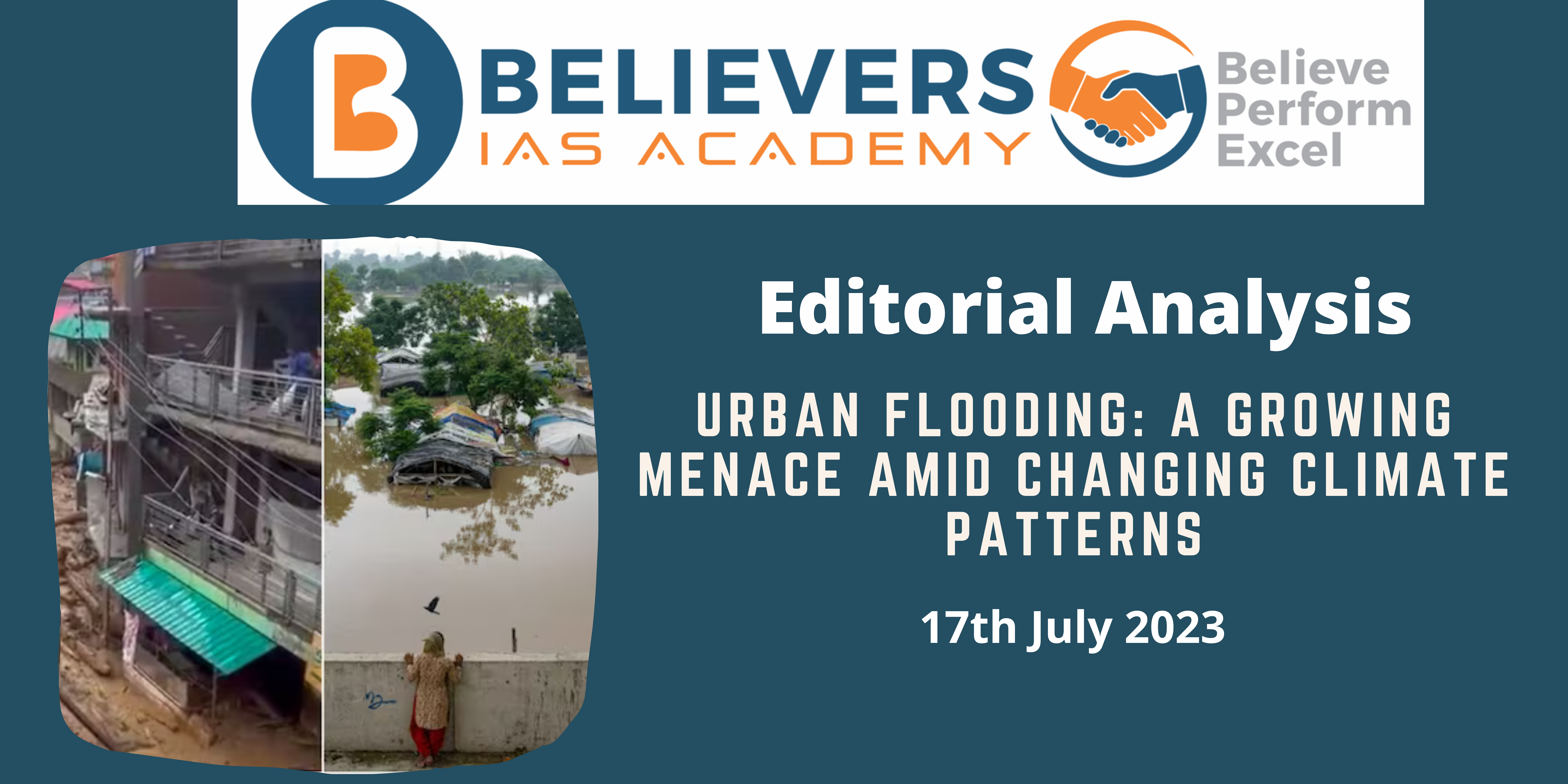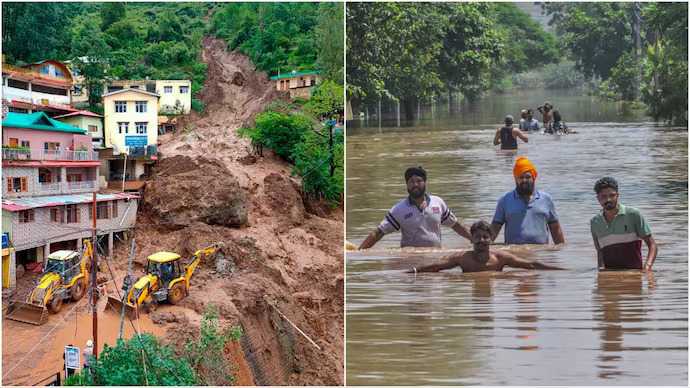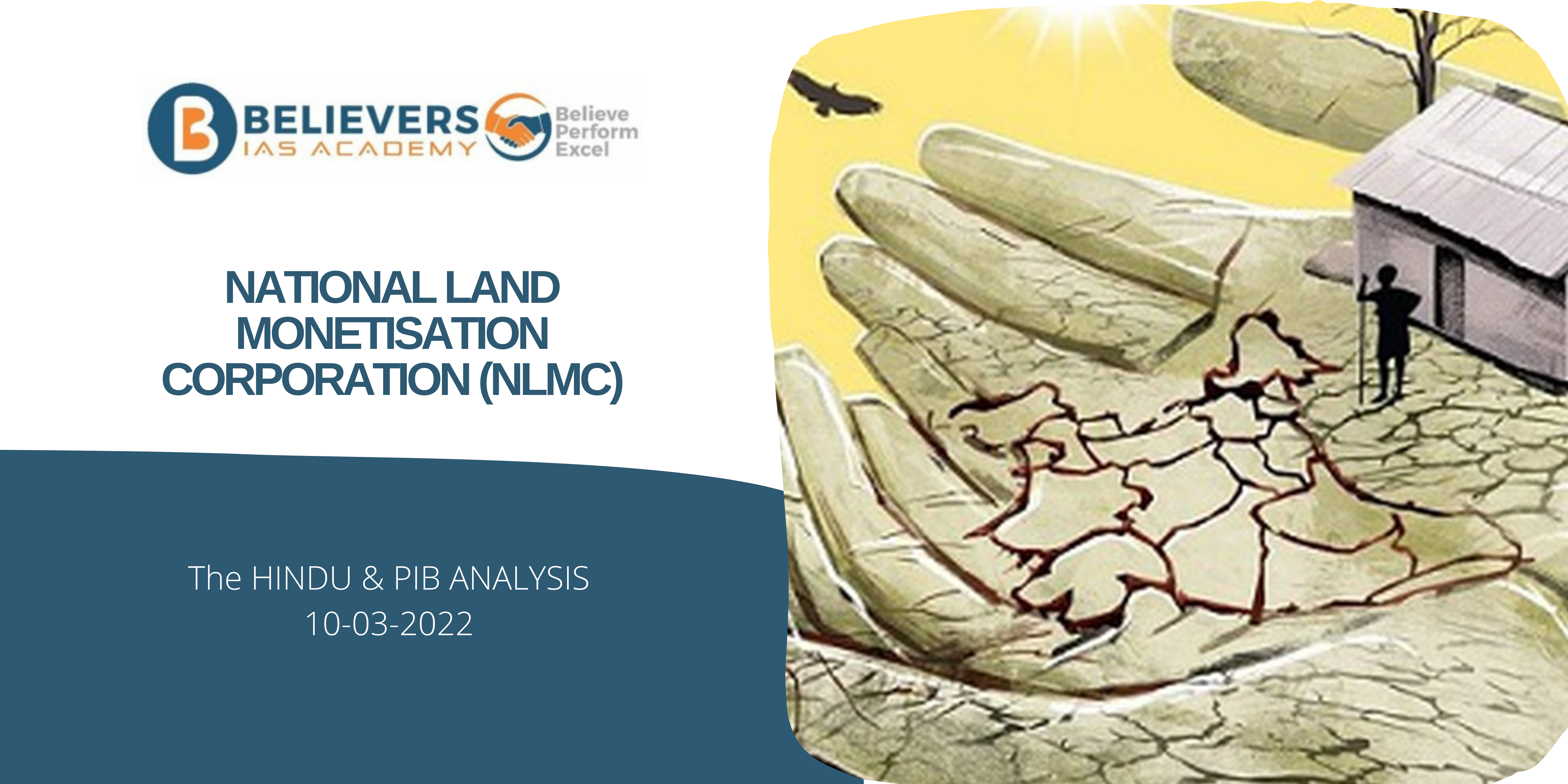Urban Flooding: A Growing Menace Amid Changing Climate Patterns
Context:
The recent devastating floods in North India have drawn attention to the interconnected issues of climate change, urbanization, and infrastructural challenges plaguing India’s major cities. As the monsoon season continues, hill States like Himachal Pradesh, Punjab, Haryana, and Delhi face the risk of landslips, landslides, and severe threats to life and property. Surprisingly, even Delhi, a city not typically associated with heavy rains, has experienced inundation, shedding light on the looming disaster potential.
Relevance:
GS – 1 (Important Geophysical Phenomena)
GS – 3 (Disaster Management) (Environmental Pollution & Degradation)
Prelims:
Floods, Monsoon, Western Disturbance, El Nino-Southern Oscillation Indian Ocean Dipole , Climate Change National Disaster Management Plan, National Disaster Management Authority
Mains Questions:
- Discuss the factors contributing to the recent floods in North India and their implications for urban development. (150 words)
- Suggest a joint strategy that States can evolve to combat the increasing risks of floods and protect their populations and infrastructures. (150 words)
Dimensions of the article:
- Emergence of Disaster Hotspots
- Deconstructing Delhi’s Deluge
- Blame the River, but Beware of Infrastructural Indifference
- Anticipating the Future: Climate Trends and Urban Expansion
Emergence of Disaster Hotspots
- The recent spate of floods across North India has thrown the spotlight on the intricate relationship between climate change, rapid urbanization, and the critical gaps in infrastructure planning.
- With the monsoon in full swing, the hilly regions bear the brunt of torrential rains, resulting in landslips, landslides, and heightened risks to both lives and properties.
- Tragically, the regions of Himachal Pradesh, Punjab, Haryana, and Delhi have experienced record rainfall, causing confirmed fatalities exceeding 60 and counting. However, it is the unexpected inundation of Delhi, a metropolis not commonly associated with floods, that demands immediate national attention to the impending disasters that lie ahead.
Deconstructing Delhi’s Deluge
- Delhi, the bustling National Capital Territory, finds itself submerged in the terminology of the India Meteorological Department, which labels its recent rainfall as “excess” and “large excess” for five out of eight days from July 3-10.
- On a single day, July 9, the city recorded a staggering 221.4 mm of rain, surpassing the average July rainfall of 209.7 mm. While this substantial rainfall undoubtedly contributed to the flooding, it is noteworthy that precipitation has considerably dwindled in the past few days.
- Despite the reduction in rainfall intensity, significant portions of the city, encompassing prominent landmarks like the Red Fort and the Supreme Court, remain submerged.
Blame the River, but Beware of Infrastructural Indifference
- Delhi’s officials swiftly pointed fingers at the flooding Yamuna, blaming the overflow from upstream States, particularly at Yamuna-nagar in Haryana.
- The ineffective regulation and redirection of the river’s flow by Delhi’s barrages added to the woes. However, this simplistic attribution fails to acknowledge the city’s own infrastructural shortcomings, which over the years have failed to curb construction on the Yamuna’s floodplains, neglected the timely desilting of drains before monsoons, and carelessly embraced the rampant concretization of urban landscapes.
- Moreover, upstream riverbed mining in Haryana contributes to massive silt deposits that obstruct the river’s natural course. Playing the blame game and attributing the calamity solely to “record rains” is not only unproductive but also evades the pressing realities.
Anticipating the Future: Climate Trends and Urban Expansion
- With warming trends in the Arctic and the Arabian Sea, the likelihood of more extreme rain spells has surged.
- The implications of urban flooding are not unique to Delhi; cities like Bengaluru, Chennai, and Mumbai grapple with the issue more frequently.
- Delhi, with its ever-expanding population and infrastructural demands, can no longer claim immunity to such catastrophes.
- The urgency to act in concert is evident, much like the collaborative approach taken to tackle air pollution, recognizing its interdependence on the efforts of all cities.
Way Forward:
Unifying States for Flood Preparedness
- To fortify against the escalating risk of floods, States must transcend their differences and forge a collective strategy. A joint management approach, akin to the one adopted to combat air pollution, becomes imperative to mitigate the multifaceted threats that flooding poses. Collaborative initiatives should encompass comprehensive urban planning, water resource management, disaster preparedness, and infrastructural improvements.
Climate-Resilient Urban Planning
- States must prioritize resilient urban planning to steer clear of disasters like the recent floods. Regulating construction on floodplains, preserving natural drainage systems, and investing in green infrastructure will prove indispensable. Additionally, measures to enhance the adaptive capacity of cities against extreme weather events should be central to the strategy.
Inter-State Water Management
- Effective water management across States, particularly concerning rivers like the Yamuna, demands harmonized efforts. From upstream riverbed mining to downstream barrage operation, States must work together to ensure the natural flow of water is maintained without causing undue harm to downstream regions.
Investing in Disaster Preparedness
- Preparedness for future floods necessitates investments in early warning systems, resilient infrastructure, and disaster response mechanisms. Governments should collaborate on the research and implementation of cutting-edge technologies to anticipate and mitigate flooding risks effectively.
Public Participation and Awareness
- Engaging citizens in the flood resilience agenda is critical. Raising awareness about responsible urban practices, water conservation, and disaster preparedness will foster community participation and ownership in flood management.
Conclusion:
The recent floods have sounded an alarm that must not go unheeded. As climate change intensifies, the specter of urban floods looms large over India’s cities. Delhi’s recent deluge serves as a reminder that no city can claim immunity from the forces of nature. To fortify against such cataclysms, States must abandon the parochial mindset and embark on a collaborative journey. Together, they can engineer a resilient strategy that intertwines the principles of environmental stewardship, sustainable development, and public welfare. The unity in purpose will safeguard cities and their inhabitants from the wrath of floods and nurture a brighter and more resilient urban future.





